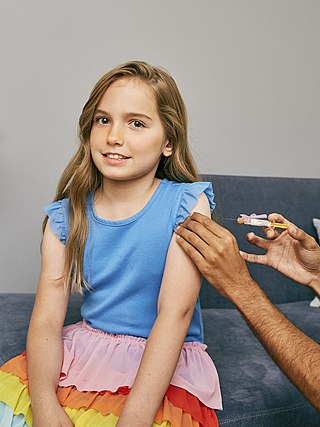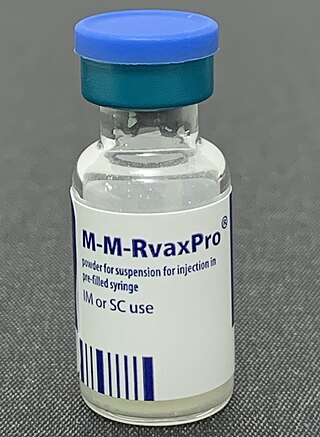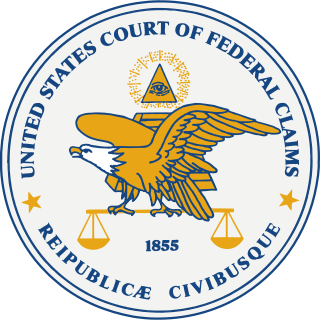Related Research Articles

Vaccination is the administration of a vaccine to help the immune system develop immunity from a disease. Vaccines contain a microorganism or virus in a weakened, live or killed state, or proteins or toxins from the organism. In stimulating the body's adaptive immunity, they help prevent sickness from an infectious disease. When a sufficiently large percentage of a population has been vaccinated, herd immunity results. Herd immunity protects those who may be immunocompromised and cannot get a vaccine because even a weakened version would harm them. The effectiveness of vaccination has been widely studied and verified. Vaccination is the most effective method of preventing infectious diseases; widespread immunity due to vaccination is largely responsible for the worldwide eradication of smallpox and the elimination of diseases such as polio and tetanus from much of the world. However, some diseases, such as measles outbreaks in America, have seen rising cases due to relatively low vaccination rates in the 2010s – attributed, in part, to vaccine hesitancy. According to the World Health Organization, vaccination prevents 3.5–5 million deaths per year.

The MMR vaccine is a vaccine against measles, mumps, and rubella, abbreviated as MMR. The first dose is generally given to children around 9 months to 15 months of age, with a second dose at 15 months to 6 years of age, with at least four weeks between the doses. After two doses, 97% of people are protected against measles, 88% against mumps, and at least 97% against rubella. The vaccine is also recommended for those who do not have evidence of immunity, those with well-controlled HIV/AIDS, and within 72 hours of exposure to measles among those who are incompletely immunized. It is given by injection.

Thiomersal (INN), or thimerosal, is an organomercury compound. It is a well-established antiseptic and antifungal agent.

Measles morbillivirus(MeV), also called measles virus (MV), is a single-stranded, negative-sense, enveloped, non-segmented RNA virus of the genus Morbillivirus within the family Paramyxoviridae. It is the cause of measles. Humans are the natural hosts of the virus; no animal reservoirs are known to exist.

Vaccine hesitancy is a delay in acceptance, or refusal, of vaccines despite the availability of vaccine services and supporting evidence. The term covers refusals to vaccinate, delaying vaccines, accepting vaccines but remaining uncertain about their use, or using certain vaccines but not others. The scientific consensus that vaccines are generally safe and effective is overwhelming. Vaccine hesitancy often results in disease outbreaks and deaths from vaccine-preventable diseases. Therefore, the World Health Organization characterizes vaccine hesitancy as one of the top ten global health threats.
Neurodevelopmental disorders are a group of conditions that begin to produce symptoms during childhood. According to the American Psychiatric Association Diagnostic and Statistical Manual of Mental Disorders, Fifth Edition, (DSM-5) published in 2013, these conditions generally appear in early childhood, usually before children start school, and can persist into adulthood. The key characteristic of all these disorders is that they negatively impact a person's functioning in one or more domains of life depending on the disorder and deficits it has caused. All of these disorders and their levels of impairment exist on a spectrum, and affected individuals can experience varying degrees of symptoms and deficits, despite having the same diagnosis.
Thiomersal is a mercury compound which is used as a preservative in some vaccines. Anti-vaccination activists promoting the incorrect claim that vaccination causes autism have asserted that the mercury in thiomersal is the cause. There is no scientific evidence to support this claim. The idea that thiomersal in vaccines might have detrimental effects originated with anti-vaccination activists and was sustained by them and especially through the action of plaintiffs' lawyers.

The causes of autism are environmental or genetic factors that predispose an individual to develop autism, also known as autism spectrum disorder (ASD). Many causes of autism have been proposed, but understanding of the theory of causation of autism is incomplete. Attempts have been made to incorporate the known genetic and environmental causes into a comprehensive causative framework. ASD is a neurodevelopmental disorder marked by impairments in communicative ability and social interaction and restricted/repetitive behaviors, interests, or activities not suitable for the individual's developmental stage. The severity of symptoms and functional impairment vary between individuals.

The Office of Special Masters of the U.S. Court of Federal Claims, popularly known as "vaccine court", administers a no-fault system for litigating vaccine injury claims. These claims against vaccine manufacturers cannot normally be filed in state or federal civil courts, but instead must be heard in the U.S. Court of Federal Claims, sitting without a jury.
Claims of a link between the MMR vaccine and autism have been extensively investigated and found to be false. The link was first suggested in the early 1990s and came to public notice largely as a result of the 1998 Lancet MMR autism fraud, characterised as "perhaps the most damaging medical hoax of the last 100 years". The fraudulent research paper authored by Andrew Wakefield and published in The Lancet falsely claimed the vaccine was linked to colitis and autism spectrum disorders. The paper was retracted in 2010 but is still cited by anti-vaxxers.

Andrew Jeremy Wakefield is a British anti-vaccine activist, former physician, and discredited academic who was struck off the medical register for his involvement in The Lancet MMR autism fraud, a 1998 study that fraudulently claimed a link between the measles, mumps, and rubella (MMR) vaccine and autism. He has subsequently become known for anti-vaccination activism. Publicity around the 1998 study caused a sharp decline in vaccination uptake, leading to a number of outbreaks of measles around the world. He was a surgeon on the liver transplant programme at the Royal Free Hospital in London and became senior lecturer and honorary consultant in experimental gastroenterology at the Royal Free and University College School of Medicine. He resigned from his positions there in 2001, "by mutual agreement", then moved to the United States. In 2004, Wakefield co-founded and began working at the Thoughtful House research center in Austin, Texas, serving as executive director there until February 2010, when he resigned in the wake of findings against him by the British General Medical Council.

Walter Ian Lipkin is the John Snow Professor of Epidemiology at the Mailman School of Public Health at Columbia University and a professor of Neurology and Pathology at the College of Physicians and Surgeons at Columbia University. He is also director of the Center for Infection and Immunity, an academic laboratory for microbe hunting in acute and chronic diseases. Lipkin is internationally recognized for his work with West Nile virus, SARS and COVID-19.
Laura Charlotte Hewitson is a British-born primate researcher noted for her work in the fields of reproductive biology and behavior. She is an affiliate scientist at the Washington National Primate Research Center (WaNPRC) and an adjunct associate professor of psychiatry at the University of Texas Southwestern Medical Center. Additionally, she is the Research Director of the Johnson Center for Child Health and Development in Austin, Texas. Hewitson was a staff scientist at Oregon Health Sciences University from 1997 to 2001. From 2002 to 2010 she was an associate professor of obstetrics, gynecology and reproductive sciences at the University of Pittsburgh School of Medicine and a member of the Magee-Women's Research Institute and Foundation (MWRI&F) in Pittsburgh, Pennsylvania.

Michelle Cedillo v. Secretary of Health and Human Services, also known as Cedillo, was a court case involving the family of Michelle Cedillo, an autistic girl whose parents sued the United States government because they believed that her autism was caused by her receipt of both the measles-mumps-and-rubella vaccine and thimerosal-containing vaccines. The case was a part of the Omnibus Autism Proceeding, where petitioners were required to present three test cases for each proposed mechanism by which vaccines had, according to them, caused their children's autism; Cedillo was the first such case for the MMR-and-thimerosal hypothesis.
Hurair Vasken Aposhian was a Ph.D. toxicologist and an emeritus professor of molecular and cell biology at the University of Arizona, a post he held beginning in 1975. He is also a former professor of pharmacology at the medical school at said university. He received his bachelor's degree in chemistry, at Brown University, 1948. He received a master's degree and a PhD in physiological chemistry at the University of Rochester, where he published some scientific studies about the synthesis of isoalloxazine ring-containing compounds. He did a postdoctoral with Nobel Laureate Arthur Kornberg in the department of biochemistry at Stanford University School of Medicine. He has done sabbatical scholar-in-residence at MIT and at the University of California at San Diego. He is best known for his pioneering work on Succimer and Unithiol in the treatment of arsenic, mercury, lead and other heavy metals leading to FDA approval of succimer in childhood lead poisoning at levels over 40 ug/dl. Previous posts he had held include at Vanderbilt, Tufts University, and the University of Maryland. His views about mercury in vaccines and in dental amalgams go against the consensus of the medical community and are controversial.
Frank DeStefano FACPM is a medical epidemiologist and researcher at the Centers for Disease Control and Prevention, where he is director of the Immunization Safety Office.

Vijendra Kumar Singh is a neuroimmunologist who formerly held a post at Utah State University, prior to which he was a professor at the University of Michigan. While affiliated with both institutions, he conducted some controversial autism-related research focusing on the potential role of immune system disorders in the etiology of autism. For example, he has testified before a US congressional committee that, in his view, "three quarters of autistic children suffer from an autoimmune disease."
Paul Ashwood is an associate professor of immunology at the MIND Institute at the University of California Davis. His lab conducts research regarding the potential role of immune system disorders in autism, as well as other neurodevelopmental disorders such as Fragile X syndrome, Tourette syndrome, schizophrenia and mood disorders.
The development of an animal model of autism is one approach researchers use to study potential causes of autism. Given the complexity of autism and its etiology, researchers often focus only on single features of autism when using animal models.
Timothy M. Buie is a pediatric gastroenterologist at Boston Children’s Hospital. Buie joined Harvard Medical School in 1998 after previously practicing at Pediatric Gastroenterology Associates for eight years. He was also the director of Gastrointestinal and Nutritional Services at MGH's Lurie Center for Autism. He is well known for his research pertaining to the possible connection between autism and gastrointestinal disorders, and has told the Interagency Autism Coordinating Committee that over half of autistic children experience gastrointestinal symptoms, whereas he stated that this was the case for "between 50 and 70%" of children with autism in an interview with ABC News. He has also said that a subset of autistic children may benefit from gluten-free, casein-free diets, and that more research is needed into this area. Buie was honored as "Professional of the Year" by the Autism Society of America in 2009.
References
- ↑ Hornig-Rohan, Mady (2001). Treatment-Resistant Mood Disorders. Cambridge University Press. pp. iv.
- ↑ "Mady Hornig, Columbia University". December 2022.
- 1 2 Kirkland, A. (2012). "Credibility battles in the autism litigation". Social Studies of Science. 42 (2): 237–61. doi:10.1177/0306312711435832. PMID 22848999. S2CID 1798838.
- ↑ "Mady Hornig, M.A., M.D." harvard.edu.
- 1 2 Flam, Faye (23 July 1996). "Is Depression Viral?". Chicago Tribune. Retrieved 14 February 2015.
- ↑ Hornig, M.; Briese, T.; Buie, T.; Bauman, M. L.; Lauwers, G.; Siemetzki, U.; Hummel, K.; Rota, P. A.; Bellini, W. J.; O'Leary, J. J.; Sheils, O.; Alden, E.; Pickering, L.; Lipkin, W. I. (2008). Cookson, Mark R (ed.). "Lack of Association between Measles Virus Vaccine and Autism with Enteropathy: A Case-Control Study". PLOS ONE. 3 (9): e3140. Bibcode:2008PLoSO...3.3140H. doi: 10.1371/journal.pone.0003140 . PMC 2526159 . PMID 18769550.
- ↑ McKenzie, John (3 September 2008). "Study Finds Vaccine Not Linked to Autism". ABC News . Retrieved 10 October 2013.
- ↑ Rubenstein, Sarah (8 September 2008). "Study Shows 'No Connection' Between Measles Vaccine, Autism". Wall Street Journal . Retrieved 12 October 2013.
- ↑ Williams, B. L.; Hornig, M.; Buie, T.; Bauman, M. L.; Cho Paik, M.; Wick, I.; Bennett, A.; Jabado, O.; Hirschberg, D. L.; Lipkin, W. I. (2011). Jacobson, Steven (ed.). "Impaired Carbohydrate Digestion and Transport and Mucosal Dysbiosis in the Intestines of Children with Autism and Gastrointestinal Disturbances". PLOS ONE. 6 (9): e24585. Bibcode:2011PLoSO...624585W. doi: 10.1371/journal.pone.0024585 . PMC 3174969 . PMID 21949732.
- ↑ "Children With Autism and Gastrointestinal Symptoms Have Altered Digestive Genes". ScienceDaily . 18 September 2011. Retrieved 12 October 2013.
- ↑ Hornig, M.; Montoya, J. G.; Klimas, N. G.; Levine, S.; Felsenstein, D.; Bateman, L.; Peterson, D. L.; Gottschalk, C. G.; Schultz, A. F.; Che, X.; Eddy, M. L.; Komaroff, A. L.; Lipkin, W. I. (27 February 2015). "Distinct plasma immune signatures in ME/CFS are present early in the course of illness". Science Advances. 1 (1): e1400121. Bibcode:2015SciA....1E0121H. doi:10.1126/sciadv.1400121. PMC 4465185 . PMID 26079000.
- ↑ "Distinct stages to chronic fatigue syndrome identified". BBC News. 28 February 2015. Retrieved 13 September 2015.
- ↑ Hornig M, Weissenböck H, Horscroft N, Lipkin WI (1999). "An infection-based model of neurodevelopmental damage". Proc Natl Acad Sci USA. 96 (21): 12102–7. Bibcode:1999PNAS...9612102H. doi: 10.1073/pnas.96.21.12102 . PMC 18419 . PMID 10518583.
- ↑ Hornig M, Chian D, Lipkin WI (September 2004). "Neurotoxic effects of postnatal thimerosal are mouse strain dependent". Mol. Psychiatry. 9 (9): 833–45. doi:10.1038/sj.mp.4001529. PMID 15184908.
- ↑ Licinio, Julio (8 June 2004). "Thimerosal, found in childhood vaccines, can increase the risk of autism-like damage in mice". Eurekalert! . Retrieved 10 October 2013.
- ↑ Maugh, Thomas H., II (9 June 2004). "Study Finds Genetic Link Between Autism, Vaccines". Los Angeles Times . Retrieved 10 October 2013.
{{cite web}}: CS1 maint: multiple names: authors list (link) - ↑ Offit, Paul A. (2008). Autism's False Prophets: Bad Science, Risky Medicine, and the Search for a Cure . Columbia University Press. ISBN 978-0-231-14636-4.
- ↑ Barclay, Laurie (11 June 2004). "IOM Report, Mouse Study Continue Debate on Vaccine-Autism Link". Medscape . Retrieved 10 October 2013.
- ↑ Pessah, I. N.; Seegal, R. F.; Lein, P. J.; Lasalle, J.; Yee, B. K.; Van De Water, J.; Berman, R. F. (2008). "Immunologic and neurodevelopmental susceptibilities of autism". NeuroToxicology. 29 (3): 532–545. doi:10.1016/j.neuro.2008.02.006. PMC 2475601 . PMID 18394707.
- ↑ "The Age of Autism: New test of gold salts". UPI.
- ↑ Yaddanapudi K, Hornig M, Serge R, et al. (July 2010). "Passive transfer of streptococcus-induced antibodies reproduces behavioral disturbances in a mouse model of pediatric autoimmune neuropsychiatric disorders associated with streptococcal infection". Mol. Psychiatry. 15 (7): 712–26. doi:10.1038/mp.2009.77. PMID 19668249.
- ↑ Westly, Erica (18 January 2010). "From Throat to Mind: Strep Today, Anxiety Later?". Scientific American . doi:10.1038/scientificamericanmind0110-17a . Retrieved 25 December 2013.
- ↑ "Antibodies to strep throat bacteria linked to obsessive compulsive disorder in mice - (e) Science News". esciencenews.com.
- ↑ Williams, Edgar (27 May 1988). "A New Medical Team Faces Life And Debt Together". Philly.com . Retrieved 10 October 2013.